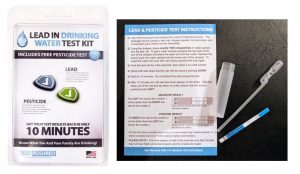 Pesticide Use Is Increasing
Pesticide Use Is Increasing
The United States is one of the largest food producers in the world. As a result, the use of pesticides in this country has continued to rise. Pesticides have helped the US hold its position at the forefront of food production. These chemicals make it possible to control insects and weeds to maximize the harvest size and increase the amount of food produced. Although plentiful crops are good for farmers and our economy, there is a downside to our reliance on pesticides. Eventually, these chemicals find their way into our water systems, contaminating our drinking water and creating a potential threat to human health.
Who Is at Risk for Pesticide Contamination?
According to the Safe Drinking Water Act of 1974, the Environmental Protection Agency and other government agencies are charged with regulating and monitoring the country’s water supply. Because of this, public water sources are regularly tested to ensure that contaminants are minimal. However, if your water comes from a private water source, such as a well, there are no government regulations in place to protect the quality of the water.
Certain situations might put you at high risk for pesticide contamination. Poorly constructed, shallow, cracked, or unsealed wells can easily become contaminated by pesticides that have soaked into the soil. If you learn that a neighboring well is contaminated, there is a chance that your well water may also have been exposed to the pesticides. If you live in an area that is heavily farmed and frequently sprayed with pesticides you are at greater risk for contamination. Those who live near pesticide distributors should be concerned about pesticides polluting their water sources. Contamination also occurs when your well is close to a place where pesticides have been mixed, spilled, or dumped. In any of these situations, it is recommended that you regularly test your water for pesticides.
How Do Pesticides Get into Water?
Even when farmers take care to properly apply pesticides, they can still find their way into your water. Pesticides are designed to either bind to the plant they were meant to protect, or they will degrade and lose their toxicity. If there is rainfall before either of these two events can happen, it will carry the pesticides through the soil where they enter aquifers and contaminate the water.
Large bodies of water can become affected when pesticides are sprayed in their vicinity. Pesticides may be sprayed in or around lakes, streams, and other bodies of water when there is a problem with insects, fish or aquatic weeds. Pesticides are not meant to be used in close proximity to a water supply system.
Sometimes, people misuse pesticides, spilling or dumping them close to water sources. Homeowners have also been known to dispose of pesticides down their drains. This improper handling of pesticides increases the chances that they will find their way into the water system and end up in our drinking water.
Pesticide Levels
The Environmental Protection Agency has set Maximum Contaminant Level (MCL) for a number of water contaminants, including pesticides. These levels represent the point at which pesticides can be present in the water without causing harm. Not all the contaminants in existence are currently on this list, but the EPA has a health advisory level set for the most dangerous contaminants.
The National Primary Drinking Water Standards List includes several chemicals found in pesticides. These four chemicals on the list are popular ingredients in pesticides that are currently being produced:
| Pesticide | Dangers If Ingested |
|---|---|
| Benzene | MCL = 0.0005 mg/L, known to cause cancer |
| Endrin | MCL = 0.002 mg/L, known to cause liver, kidney, and heart damage |
| Hexachlorobenzene | MCL = 0.001 mg/L, known to cause cancer |
| Hexachlorocyclopentadiene | MCL = 0.05 mg/L, known to cause kidney and stomach damage |
Health Dangers of Pesticide in Your Water
The EPA has identified many of the chemicals that make up pesticides as health risks when they are found in drinking water. Because pesticides are made up of a variety of different combinations of chemicals, the toxicity of the contaminant and how much you ingest determines the severity of the health concerns.
The health effects of pesticides include immediate effects from short-term exposure and the more serious effects from prolonged exposure. How long and how often you are exposed to the pesticide plays a role in the level of toxicity. It also depends on whether or not you are particularly sensitive to a pesticide.
Typically, the levels of pesticides that are found in drinking water contribute to chronic and long-term health problems. Chronic issues include diarrhea, nausea, vomiting, abdominal pain, and skin irritation. Greater exposure to pesticides can lead to much more serious health problems such as cancer, birth defects, genetic mutations, liver damage, and central nervous system damage.
If your water tests higher than the EPA MCL, it means the level of pesticides in the water could be a health risk. They set these levels based on animal studies that were conducted over a long period of time. If your water contains contaminants at higher levels, you should stop drinking it immediately.
How to Test Your Water for Pesticide
To find out if your water contains pesticides, you may want to have a sample analyzed by a professional laboratory where it can be screened for contaminants. The Department of Public Health can recommend local water testing companies.
Another option is to purchase a water testing kit to analyze your water at home. TestAssured’s Pesticide Test allows you to test your water quickly to make sure it does not contain pesticides.
 To perform the pesticide test:
To perform the pesticide test:
- Use the dropper pipette to place exactly two dropperfuls of your water sample into the test vial.
- Swirl the test vial for a few seconds, then place it on a flat surface.
- Place the test strip into the vial with the arrows pointing down.
- Wait for 10 minutes.
- After 10 minutes, remove the strip from the vial, lay it on a flat surface and review the instruction card to determine if your result is positive or negative.
If the test strip shows a positive result, then your water sample may contain toxic levels of pesticides. Further testing is highly recommended.
What Happens if Your Water Contains Pesticides?
If your water tests positive for pesticides, further testing is needed to confirm the exact level of pesticide in the water. These levels should be compared to the MCLs set by the EPA to determine if the water is unsafe.
Keep in mind that pesticide levels can fluctuate. If it has recently rained, there may be a sudden spike in pesticide levels. Also, the levels tend to go up and down over time depending on the usage patterns of pesticides in the vicinity of the water source.
When you have a positive test for pesticides in your water, you will need to contact your state health department and the department of agriculture. You may be required to do additional more specific tests. After you have identified the exact pesticide and quantity present in your water, the public health department will be able to give you a health advisory summary. The summary will let you know if there are any non-cancer or cancer health risks in your water.
You may or may not be suffering from the effects of contaminants in your water. Either way, it is important to visit your physician to ensure that any health concerns are addressed immediately.
How to Eliminate Pesticides from Drinking Water
After you have determined that your water contains pesticides, you should contact your regional EPA office for advice on the best method to remove the particular pesticide that is present in your water. Using an activated carbon water filter is an effective method to remove pesticides from the water before drinking. If you have a private well that has become contaminated, a common solution is to dig a deeper well.
The best way to eliminate pesticides from drinking water is prevention. Choose pesticides that are short-lived and not easily absorbed into the groundwater. Always read the labels to make sure you are using and disposing of pesticides correctly.
